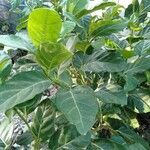Trees or shrublike trees; dioecious. Bark pale brown to yellowish brown, furrowed and scarred. Branchlets thick, cylindric. Stipules red, ovate-lanceolate, 2-3 cm, membranous. Leaves alternate; petiole 2-8 cm; leaf blade oblong, ovate-elliptic, or obovate, 15-26 × 10-14 cm, membranous, base broadly cuneate, margin entire, pubescent when young, apex acuminate, mucronate, or sometimes caudate; basal lateral veins 2-4 and short, secondary veins 6-12 on each side of midvein. Figs axillary on normal leafy shoots, solitary or paired, green to pale brown, depressed globose, with 8-12 longitudinal ridges, 1.2-2.5 cm in diam., with scattered white globose to ellipsoid tubercles and white small spots, apical pore open when mature; peduncle 6-13 mm; involucral bracts broadly ovate, margin revolute; lateral bracts absent. Male flowers: few, near apical pore; calyx lobes 2 or 3, basally connate; stamen 1; filament short; anther ellipsoid. Gall flowers: long pedicellate; calyx lobes short, transparent, apically with a few hairs; ovary ovoid to ± globose, smooth; style lateral to subapical, short; stigma enlarged. Female flowers: long pedicellate; calyx lobes apically with 2 or 3 teeth; style persistent, long, apex with transparent pubescence; stigma clavate. Achenes obliquely ovoid to ± globose. Fl. and fr. Apr-May.
Tree to 15 m high, glabrous, branches often pendulous. Leaves alternate (or opposite); lamina elliptic, ovate or oblong, 8–20 (–25) cm long, 4–7 cm wide, cuneate at base, entire margin, acuminate at apex; lateral veins 9–11 pairs; petiole 2–5 cm long; stipules 1.2–5 cm long. Figs axillary, cauliflorous or ramiflorous, pedunculate, obovoid to depressed-globular, c. 1.5–2.4 cm diam., green to cream or brownish, usually dotted, often with 6–8 longitudinal ribs; ostiole often sunken, ostiolar bracts sometimes forming a slightly raised crown 3 mm diam.; basal bracts 3, 1–1.5 mm long, forming a collar. Male flowers: stamen 1. Female flowers with united sepals.
A fig. It is an evergreen tree. It grows 6-12 m high. The small branches are stout and 4-6 mm across. The leaves are oblong and 15-25 cm long by 8-13 cm wide. The figs are round and flattened. They are 10 mm long and 15 mm across. They have even white spots. They have ridges along them.






